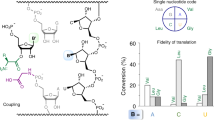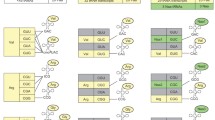Abstract
To elucidate the integrated functional properties and organization strategy of the peptide elongation process of ribosomes on messenger RNA, we took a theoretical approach by applying a linear system analysis and optimal hypothesis. The basic theoretical model published by Gerst in 1965 was founded on reported experimental data. We have simplified the mechanism of the peptide elongation process by making the following assumptions. (1) When the left-most site (the 5′ terminal) on the messenger RNA is empty, the newly arrived amino-acyl-transfer-RNA (AT) links to the 5′ terminal even though other sites are empty. (2) When all other sites on the ribosomes except the 5′ terminal are empty and the first ribosome is not yet filled, ATs which arrive subsequently continue to bind to the 5′ terminal site of the first ribosome until the first ribosome has been filled. (3) When a given ribosome has been filled by an amount of product equivalent to the product ofp (amino acid residues) andq ribosomes, the filled ribosome advances to the next ribosomal region (q+1). There, the amino acid attainspq+1. After this transition, theqth ribosomal region becomes empty. (4) When the sites on the ribosomes are not all filled, newly arrived AT binds from the right of the total sequence. By applying the mass action law, the elongation process was expressed by 23 rate equations. The rate constants for the binding ribosome, turn over, peptide bond formation and transitional movement of ribosomes were utilized from reported experimental data. The optimal state was defined when the square of the concentration of all the transitional states and control input were minimized. This means that the elongation process is in the most economical state when there are no excessive changes at any steps of the elongation process and the least energy consumption. Linear system analysis showed that system was stable and controllable. The singular value was depressed by system optimization. The impulse response terminated earlier by a smaller peak amplitude in the optimized system than in those without optimization. The present model under optimal control is available to evaluate the functions of peptide synthesis on a messenger RNA, and to produce artificial protein from the standpoint of system optimization.
Similar content being viewed by others
References
Moldave K (1985) Eukaryotic protein synthesis. Annu Rev Biochem 54: 1109–1149
Hershey JWB (1991) Translational control in mammalian cells. Annu Rev Biochem 60: 717–755.
Hirayama H and Fukuyama Y (1997) Simulation analysis of influences of initial factors on protein synthesis on a messenger RNA. IEICE Tceh Rep MBE-97-36, pp 7–12
Rich A, et al. (1963) Cold Spring Harbor Sympsium Quarterly Biol XX: 269
Gerst I, Levine SN (1965) Kinetics of protein synthesis by polyribosomes. J Theor Biol 9: 16–36
Pontryagin LS (1962) The mathematical theory of the optimal process. Wiley, New York
Bergmann JE, Lodish HF (1979) A kinetic model of protein synthesis. J Biol Chem 254: 11927–11937
Author information
Authors and Affiliations
About this article
Cite this article
Hirayama, H., Okita, Y. & Fukuyama, Y. Optimization of growth of peptide chain by ribosomes on messenger RNA. Artificial Life and Robotics 1, 173–180 (1997). https://doi.org/10.1007/BF02471136
Received:
Accepted:
Issue Date:
DOI: https://doi.org/10.1007/BF02471136




